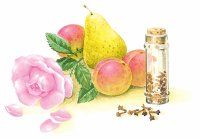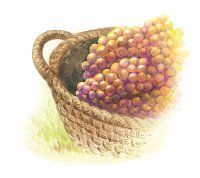How To Get White Wine Out Of Carpet
White wines tend to exist lighter in sense of taste than the red wines and are usually served chilled. Here are some of the traditional varietals:
Chardonnay
The world'south most popular varietal, Chardonnay (shar-doh-NAY) is considered to exist the greatest white wine, though Riesling lovers will dispute this. Chardonnay is grown in virtually all wine-producing countries; the result is a wine that is difficult to characterize in terms of flavors and aromas. The style varies dramatically and tin range from elegant, refined, and somewhat austere to full-bodied, rich, and opulent. Information technology all depends on where the grapes are grown and the winemaker's techniques. Contrast, for instance, the more total-diddled Californian and Australian versions with their French counterparts, Chablis and the white Burgundies of the Cote de Beaune, which tend to be more restrained and exhibit higher acidity.
Of all the white wines, Chardonnay takes to oak-barrel treatment the best; oak-influenced aromas and flavors of toastiness and smokiness sometimes dominate Chardonnay's fruit flavors, which include (depending on the origin of the grapes) apple, pear, peach, white melon, citrus, and tropical fruits such as pineapple, papaya, guava, and banana.
Most Americans seem to prefer Chardonnays that take a rich, buttery oral fissure experience and layered flavors that event from barrel aging and malolactic fermentation, a winemaking technique that converts tart malic acid (retrieve about bitter into an unripe light-green apple) into rounder, softer lactic acrid.
California wineries particularly noted for Chardonnay include Chalone, Chateau Montelena, Far Niente, Ferrari-Carano, Kistler, La Crema, Sanford, and Shafer.
French Chardonnay is named for the growing surface area (rather than for the grape). Examples include Chablis, Mersault, Chassagne-Montrachet, Puligny Montrachet, and Corton-Charlemagne. Oftentimes, the specific vineyard will be indicated on the label, along with the official quality designation premier cru, sometimes written as ler cru (get-go growth), or, even better, 1000 cru (great growth). Fantabulous producers include Domaine Leflaive, Joseph Drouhin, Louis Jadot, Louis Latour, Leroy, Morey, Pernot, Antonin Rodet, and Laboure-Roi.
Gewurztraminer

Considered a noble wine in Alsace, Gewurztraminer (geh-VAIRTZ-trah-mee-ner) has the distinction of being ane of the easiest wines to recognize and the hardest to spell and pronounce. It is spectacularly fragrant, with heady scents of lychee nut, rose petal, apricot, pear, and clovelike spice (gewurz is German for spice). The flavors are like to the aroma and quite pronounced; the texture is soft and velvety.
Gewurztraminer is most often made in a dry or off-dry out style, though sweetness versions (designated vendange tardive or, even sweeter, pick de grains nobles) tin besides be found.
The best examples come from Alsace and are labeled with the name of the grape, sometimes also with a vineyard designation. Notable producers include Ernest Fire, Domaine Bott-Geyl, Josmeyer, Albert Isle of mann, Trimbach, and Zind-Humbrecht. Most of the excellent American versions come from the Anderson Valley in Mendocino, California. Look for such producers as Edmeades, Handley, Lazy Creek, and Navarro.
Muscat
Another very fragrant wine (even more then than Gewurztraminer), Muscat (MUHS-caht) features grapey, floral aromas that scent sweet, though the wine is unremarkably made in an off-dry out style. The best examples come from Alsace and are made by many of the same producers who make fine Gewurztraminer.
Pinot Blanc
A dry out wine similar to Chardonnay only not as complex, with aromas and flavors of white melon and citrus, unremarkably made with lilliputian or no oak. Again, the best examples come from Alsace and are made by many of the aforementioned producers who make fine Gewurztraminer. Oregon Pinot Blancs are also quite expert, offering clean, fruity flavors and mild spice; look for wines fabricated by Amity, Foris, and WillaKenzie. Other respected names of Pinot Blanc (PEE-noh blahnk) include California's Au Bon Climat, Chalone, and Mirassou and Alsace's Zind-Humbrecht and Trimbach.
Pinot Gris

A dry out wine whose wide flavor profile ranges from apple, pear, and peach to melon, citrus, assistant, and tropical fruit. Occasionally, in that location's besides a vaguely smoky, nutty, or vanilla taste that suggests oak, which may be enhanced if oak is actually used in making the wine. Pinot Gris (PEE-noh gree) is known for its inherently opulent texture and good acidity; few dry out white wines are as silky smooth every bit a good Pinot Gris. The wine is called Pinot Grigio in Italy, where it is made in a leaner style with crisp acidity.
Long an important wine in Alsace, fine Pinot Gris is besides made in Federal republic of germany (where it'south labeled Grauburgunder) and California and Oregon (where it may exist labeled as either Pinot Gris or Pinot Grigio). Notable California producers of Pinot Gris/Grigio include Byron, Navarro, Long Vineyards, Mosby, and Swanson. Respected names in Oregon Pinot Gris include Amity, Bethel Heights, Chehalem, Elk Cove, Erath, King Manor, Oak Knoll, Ponzi, Rex Hill, and WillaKenzie.
Riesling
Regretfully underappreciated in the The states, Riesling (REECE-ling) is considered by nigh connoisseurs to exist one of the world's greatest (if not the greatest) white wine. It tin can be made in the full spectrum of styles, from bone dry out to incredibly sweet and rich. Unlike nearly white wines, Riesling can exist cellared for many years, developing remarkable depth and complication over time. Forward fruit, crisp acidity, purity, and low booze are Riesling's hallmarks.
Riesling is Germany'southward greatest and virtually important wine; superb bottlings are also made in Alsace and Republic of austria, mostly in a dry style. Its aromas are fruity, merely not grapey, and range from apple and lemon to peach and apricot, sometimes with a floral component (lemon blossom), sometimes with a minerallike edge that is usually quite complex, especially with age. When fabricated with riper, late-harvest fruit, Riesling displays varying intensities of a honeylike character. The naturally crisp acidity gives the body a certain firmness and balances the residual sugar in the wine, so that it comes across equally ripe rather than sweet, except when made in a dessert style.
In general, European Rieslings tend to exist far more complex and flavorful than those fabricated in the Usa, mainly in California, Washington, and New York, considering the special growing atmospheric condition found in the Old World can't be duplicated in this land. American Rieslings are made mostly in an off-dry to slightly sugariness style. Dry-mode Rieslings from Australia are quite impressive.
Germany's finest Riesling producers include Fritz Haag, Donnhoff, Gunderloch, von Simmern, Robert Weil, Kunstler, J. J. Prum, von Buhl, Burklin-Wolf, and Dr. Loosen. Highly recommended producers from Alsace include Zind-Humbrecht, Trimbach, Schlumberger, Marc Kreydenweiss, Marcel Deiss, Hugel, and Domaine Weinbach. Austrian producers of excellent Riesling include Hirtzberger, Prager, Pichler, Jamek, Knoll, Nikolaihof, Brundlmayer, and Nigl. In Australian Riesling, await for bottlings from Grosset, Henschke, Leasingham, Leeuwin Estate, Penfolds, Petaluma, and Wolf Blass.
Sauvignon Blanc
A dry out wine made in a variety of styles, sometimes called Fume Blanc (FOO-may BLAHNK) in the United States. In France, the vino is unremarkably labeled with the name of the producer and the region (for example, Pouilly-Fume), though "Sauvignon" sometimes appears on the labels of wines from the Loire Valley.
The hallmark of Sauvignon Blanc (SAW-vee-nyonh BLAHNK) is a pleasant grassiness or green herbaceousness, which may be quite subtle or very pronounced, depending on the winemaker. This characteristic accents aromas and flavors ranging from white melon, citrus, and subtle fig to white peach and mango. Sauvignon Blanc tin be made equally a lean, racy vino with crisp acidity or as a barrel-fermented vino with another varietal, usually Semillon, blended in for a richer palate. White Bordeaux wines are prime examples of the latter style; New Zealand offers excellent Sauvignons of the racy style with quite obvious grassy qualities.
California wineries brand Sauvignon Blancs in all possible styles. Some of them are especially noted for the vino, including Brander, Chateau St. Jean, Dry Creek Vineyard, Geyser Peak, Mason Cellars, and St. Supery.
Viognier
An exotic, fragrant dry wine with an attracting array of aromas and flavors, Viognier (VEE-oh-nyay) makes for an intriguing drinking experience. The wine'southward heady perfume consists of all or some of the following: honeysuckle, citrus blossoms, oriental lychee nuts, very ripe white melon, freshly picked peaches and apricots, and ripe pears only after they've been peeled. Your nose tells you the wine volition be sweet, but your palate is surprised to run across a dry nectar offering flavors of ripe pear, lemon-lime citrus, almond, spice, peach, and apricot, sometimes with a honeyed nuance. Lush and viscous on the palate, with more trunk than nigh Chardonnays, the wine'southward aftertaste is not at all cloying, but fresh and vibrant, impelling you to take another sip.
Viognier originated in the Rhone Valley in France. Here the wine is labeled past producer and growing area. Chateau Grillet is famous for the varietal. In the New Earth (particularly California, where Rhone varietals are increasingly popular), Viognier has found a niche with distinctive bottlings (labeled as Viognier) from Alban, Bonterra, Calera, Jade Mount, and Joseph Phelps.
White Zinfandel
Not a true white varietal, White Zinfandel (TZIN-fan-dell) is the product of winemaking techniques that rapidly dissever the juice from the skins of Crimson Zinfandel (which would otherwise provide color and tannin) when the grapes are crushed. This results in a blush wine, which is a white wine fabricated from red grapes. Nigh White Zinfandel is made from grapes grown in California's San Joaquin valley. Although a pop beverage (more than xx million cases are sold each twelvemonth), it'south not considered a serious wine.
White Zinfandel is pink or coral in color, with a low-cal body, usually somewhat sweetness or at least off-dry, with simple aromas and flavors of strawberry or cherry and a note of citrus, such as orange zest. It may likewise be slightly spritzy.
Of form white wines only tell half the story. In the next section and you'll discover the elegant and flavorful earth of red wines.
How To Get White Wine Out Of Carpet,
Source: https://recipes.howstuffworks.com/food-facts/wine-basics-ga1.htm
Posted by: quickdiew1967.blogspot.com


0 Response to "How To Get White Wine Out Of Carpet"
Post a Comment